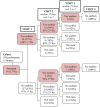Impact of an Ivermectin Mass Drug Administration on Scabies Prevalence in a Remote Australian Aboriginal Community
- PMID: 26516764
- PMCID: PMC4627839
- DOI: 10.1371/journal.pntd.0004151
Impact of an Ivermectin Mass Drug Administration on Scabies Prevalence in a Remote Australian Aboriginal Community
Abstract
Background: Scabies is endemic in many Aboriginal and Torres Strait Islander communities, with 69% of infants infected in the first year of life. We report the outcomes against scabies of two oral ivermectin mass drug administrations (MDAs) delivered 12 months apart in a remote Australian Aboriginal community.
Methods: Utilizing a before and after study design, we measured scabies prevalence through population census with sequential MDAs at baseline and month 12. Surveys at months 6 and 18 determined disease acquisition and treatment failures. Scabies infestations were diagnosed clinically with additional laboratory investigations for crusted scabies. Non-pregnant participants weighing ≥15 kg were administered a single 200 μg/kg ivermectin dose, repeated after 2-3 weeks if scabies was diagnosed, others followed a standard alternative algorithm.
Principal findings: We saw >1000 participants at each population census. Scabies prevalence fell from 4% at baseline to 1% at month 6. Prevalence rose to 9% at month 12 amongst the baseline cohort in association with an identified exposure to a presumptive crusted scabies case with a higher prevalence of 14% amongst new entries to the cohort. At month 18, scabies prevalence fell to 2%. Scabies acquisitions six months after each MDA were 1% and 2% whilst treatment failures were 6% and 5% respectively.
Conclusion: Scabies prevalence reduced in the six months after each MDA with a low risk of acquisition (1-2%). However, in a setting where living conditions are conducive to high scabies transmissibility, exposure to presumptive crusted scabies and population mobility, a sustained reduction in prevalence was not achieved.
Clinical trial registration: Australian New Zealand Clinical Trial Register (ACTRN-12609000654257).
Conflict of interest statement
The authors have declared that no competing interests exist.
Figures
References
-
- Chosidow O (2006) Scabies. New England Journal of Medicine 354: 1718–1727. - PubMed
-
- Currie B, Carapetis J (2000) Skin infections and infestations in Aboriginal communities in northern Australia. Australasian Journal of Dermatology 41: 139–145. - PubMed
-
- Carapetis JR, Connors C, Yarmirr D, Krause V, Currie BJ (1997) Success of a scabies control program in an Australian Aboriginal community. Pediatric Infectious Disease Journal 16: 494–499. - PubMed
Publication types
MeSH terms
Substances
Associated data
LinkOut - more resources
Full Text Sources
Other Literature Sources
Medical





